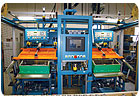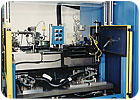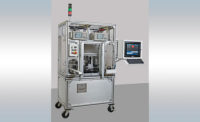
Helium makes balloons float and your voice squeak, but if you assemble a product that absolutely, positively cannot leak, this inert gas is a key ingredient of your quality control process.
An air bag inflator is a good example. Air bags are inflated either by an explosive chemical reaction or the release of highly compressed gas. The former cannot tolerate any ingress of moisture over the life of the vehicle. The latter cannot afford any loss of pressure.
The leak rate specification for pyrotechnic inflators ranges from 10-5to 10-6atmospheric cubic centimeters per second (atm-cc/sec). Because gas molecules are smaller than water molecules, the specification for compressed gas inflators is even smaller: 10-7to 10-8atm-cc/sec. The only way to detect leaks that small is with a helium-based leak detector.
“A helium leak detector can find a leak the size of one champagne bubble over 24 hours,” says Chris Goebel, director of sales and marketing forULVAC Technologies Inc.
Because they’re more sensitive-and more expensive-than air-based test methods, helium leak detectors are reserved for the most critical assemblies. In the automotive industry, they test fuel rails, tire rims, oil coolers and air-conditioning components. In the appliance industry, they check gas lines and refrigerant coils. In the medical device industry, they test pacemakers and implantable infusion pumps.
“We had one customer specify a leak rate of 10-11atm-cc/sec for an implantable medical device,” says John McLaren, marketing manager for leak detection atVarian Inc.

Because they’re more sensitive-and more expensive-than air-based leak-testing methods, helium leak detectors are reserved for the most critical assemblies. Photo courtesy InterTech Development Co.
How it Works
Helium leak testing can be performed in several ways. Most commonly, the assembly is pressurized with helium and placed inside a vacuum chamber, explains Jacques Hoffman, president ofInterTech Development Co.After air is evacuated from the chamber, a mass spectrometer tuned to helium samples the inside of the chamber. If it detects helium, the part has a leak.The chamber is usually designed specifically for the test assembly to minimize the amount of air that must be evacuated-and thus minimize cycle time.
In a variation of the vacuum method, air is not evacuated from the test chamber. Instead, the pressurized assembly is simply left alone for a set length of time to allow escaping helium to accumulate in the chamber. If the concentration of helium increases, the assembly has a leak.
With the accumulation method, “the change in concentration is inversely proportional to the volume of the chamber and directly proportional to the leak rate,” explains Quinn Talley, applications engineer atCincinnati Test Systems Inc.“The bigger the volume, the slower the concentration goes up. The higher the leak rate, the faster the concentration changes. I just looked at an application that would have taken 96 minutes to detect a leak. Obviously, that was impractical.”
“The advantage of pulling a vacuum is that you can test for lower leak rates,” adds Hoffman. “The accumulation method is cheaper, but it’s slower and less accurate.”
A third variation of helium leak testing reverses the process. The chamber is pressurized with helium, and a vacuum is drawn on the inside of the assembly. In this case, the sensor looks for helium penetrating the assembly from the outside.
“Mass spectrometer technology can measure just about any size of leak, down to...5 x 10-12atm-cc/sec. That’s a very, very small leak,” says McLaren.
A fourth variation dispenses with the vacuum chamber. The assembly is pressurized with helium, and a sniffer probe samples the air around suspected leak points, such as brazed or welded joints. The air flows past a heated quartz membrane that is only permeable to helium. Any helium in the sample will flow through the membrane to be detected by a sensor. The probe is typically handheld, but it can also be attached to a robot for automated testing.
An alternative to the probe method reverses the process. A vacuum is drawn on the inside of the assembly. Then, instead of sniffing the air for helium, the probe blows helium onto possible leak points. If there’s a leak, the helium will be drawn into the assembly where it’s detected by a sensor.
The chamber methods can quantify the magnitude of the leak, but they can’t pinpoint its location, says Talley. The probe methods can identify the source of the leak, but they can’t determine how much the assembly is leaking.
The speed of the test depends on the size of the part and how much it will be pressurized, as well as the size of the vacuum chamber and how large a vacuum is pulled.
Goebel remembers a customer that manufactures tire rims. “The company had a throughput of 2,000 rims in an eight-hour shift-that’s a lot,” he says. “You’re looking at an 8-second test time, which is pretty remarkable [considering] that you have to evacuate the chamber, charge the part with helium, run the test, and vent everything.”

To prevent false positive tests, O-rings and gaskets must be clean, smooth and free of tears or nicks. Photo courtesy VIC Leak Detection
Optimizing the Process
Like air-based leak testing, helium-based leak testing requires attention to detail. Lapses in process control will lead to false positives, false negatives and frustration.Cleanliness is critical to accurate results. “Helium is extremely clingy,” explains Goebel. “It will stick to dust particles. Compared with a helium molecule, a dust particle is very large.”
If the instrument detects helium during a test, it may not necessarily mean the part is leaking. The helium could be coming from residual gas clinging to dirt or dust in the chamber.
“The work area should be cleaned regularly with distilled water and isopropyl alcohol,” advises Goebel. “Cleanliness is next to godliness in leak testing.”
Equally important is ensuring the system itself does not leak helium. O-rings and gaskets must be clean, smooth and free of tears or nicks.
Goebel recalls one customer that was leak testing transmission housings as they came off the machining line. “The first thing I noticed was all these metal particles [on the parts], and the operator was not cleaning them off,” he says. “[When I inspected] the O-ring, it had cuts and nicks in it. It wasn’t sealing the part. Since the test was being done at a very high pressure, a lot of helium was escaping and producing a false reading.”
Similarly, assemblers need to control the background level of helium in the test environment. Helium is an ideal tracer gas for leak testing because it’s relatively rare in the atmosphere. It’s present at a concentration of 5 parts per million. System leaks or poor venting practices can cause the background level of helium to rise above 5 parts per million, which could lead to false positive tests.
Goebel remembers a customer that made radiators. “In the morning, the leak test system ran fine,” he says. “By the afternoon, there was so much residual helium in the environment that the background level of helium was actually at the pass-fail limit for the part.”
If assemblers are not recovering and reusing the helium, the test gas should be vented outside the building. Pumps should be strategically located and maintained regularly. Vacuum lines should be leak-free.
“Some customers will use dry nitrogen to purge atmospheric helium from the system,” adds Talley. “In tough applications, you can’t rely on passive measures to control background helium.”

This system checks fuel tanks for leaks in approximately 60 seconds. This test was tricky, because the part cannot tolerate a large pressure differential. Photo courtesy Cincinnati Test Systems Inc.
Conserving Helium
Thanks to shrinking supplies and rising demand, the price of helium has risen sharply since 2007. As a result, assemblers are increasingly looking for ways to reduce helium costs.One way to do that is by using less helium in the test. Rather than 100 percent helium, the assembly could be filled with a mixture of helium and air or helium and nitrogen.
“If you are using 100 percent helium in your test, I can almost guarantee you’re using more helium than you need,” asserts Goebel. “If you ran a design of experiments...you’ll find that you could reduce your costs by mixing helium with air or nitrogen.”
If assemblers use less helium in the test, they may have to compensate by boosting the pressure in the test part or decreasing the vacuum in the chamber. For example, if the part was pressurized to 20 psi with 100 percent helium, it may need to be pressurized to 40 psi with a 50 percent helium mixture or 90 psi with a 10 percent helium mixture. This could increase overall cycle time.
Some manufacturers save helium by using an air-based leak test method to screen assemblies for gross leaks, says McLaren. If the part has a gross leak, there’s no need to expend costly helium to look for minute leaks.
Another way to save helium is to recover and reuse the gas rather than vent it outside. “From 2004 to 2008, nine out of 10 sales leads were for automated leak test systems and one would be for helium recovery equipment,” says Goebel. “Today, that’s reversed. Eight out of 10 leads we get now are for helium recovery systems.”
Besides a controller, valves and piping, a helium recovery system consists of several tanks, one or more compressors, and a gas analyzer, says Chuck Wilkinson, corporate marketing director forVacuum Instrument Corp.A typical system is a little larger than a good-sized household refrigerator.
At the end of a leak test, the helium is released from the assembly and vented to a vacuum tank. From there, it is pumped under pressure to one or more additional tanks. During each stage, the helium passes through high-efficiency heat exchangers to remove the heat generated during compression. The final compressor outputs to a tank that pressurizes the test assembly. By the time it reaches the final tank, the helium should be compressed to 25 percent above the pressure required to test the part.
Such a system can recover as much as 98 percent of the helium used during testing. If an assembler consumes $630 in helium daily, a recovery system will pay for itself in less than two years, says Wilkinson.
ASSEMBLY ONLINE
For more information on leak testing, visit www.assemblymag.com to read these articles:
*How to Select the Right Method to Leak-Test Your Products.
*The Latest in Leak Detection.
*Assembly in Action: Hydrogen Leak Detectors Test Catheters.

